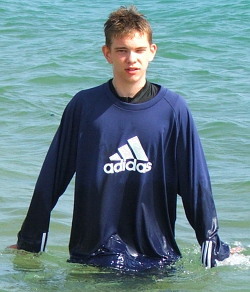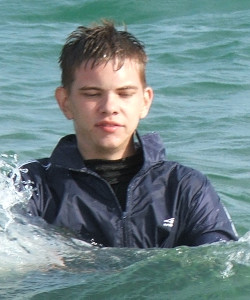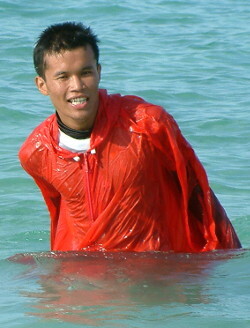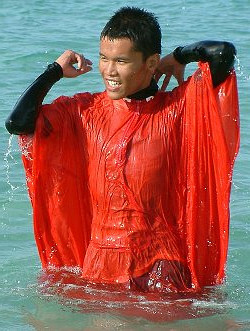Clothing Layers for Warmth and Comfort
Dress for immersion. Several layers of clothes let you adapt to changing weather.
On a multi-day hike along the coast or a short canoeing trip, nothing can ruin an outdoor adventure more than poorly performing watersports clothes. You'll probably get soaking wet and then want to stay warm. If you get too cold you will be uncomfortable.
Water Temperature Matters
Consider the water, not the air temperature. It is wise to dress in a way that keeps you warm and comfortable when there is a chance that you go into the water. If you get too hot you can always cool down with a quick dip. Staying warm is a greater challenge.
Choose clothes for existing and expected conditions which provide warmth even when wet. Several layers of thin clothing reduce heat loss better and thus keep you warmer than just one or two thick layers. Man-made fibres are warmer than wet cotton. Fleece clothes work best.
Extreme cold requires wetsuits or drysuits, but in more moderate conditions
you can use layers of more comfortable functional clothing.
Cotton clothes should never be worn in cold conditions because they "wick" heat away from the body when wet,
accelerating the affects of hypothermia.
Jeans can get cold when wet.
Base Layer
The base layer reduces water flow past your skin. You can also wear it for sunburn protection on its own.
Start with a moisture management layer next to the skin, a base layer that wicks perspiration away from your body. Kokatat makes an Inner Core line; NRS has HydroSilk and MicroLite; Immersion Research offers a Thin Skin material. Look for wicking, quick-drying material.
Your first layer of clothing should be skin tight. It reduces water flow past your skin when swimming and forms a thin water layer that warms up a bit. Man-made fibres are better as they don't hold much water. Materials like polypropylene and polyester tend to resist water retention best and you warm up faster after your swim. Lycra suits are also helpful.
Cotton is very comfortable for swimming. It soaks up lots of water and gets heavy which makes it ideal for power training in pools. But out of the water it retains a high level of moisture and also holds water against your skin, rapidly moving heat away from your body. It's one of the worst materials for staying warm when wet.
Around camp or home you just wear the base layer, maybe the fleece. When swimming, wear the base layer or the windproof top, or both.
Middle Layer
The middle or insulating layer is designed to keep you warm when it gets colder and is worn over a base layer and under an outer layer. Made from synthetic thermal fibres, it assists the movement of moisture to the outer layer. These fibres should not absorb much water; they should dry quickly and so keep you warmer.
Tracksuits are inexpensive and and probably the comfortable middle layer. Hooded tops reduce windchill and sunburn risk. Unlined tracksuits don't hold much water, it runs out quickly and the fabric dries reasonably fast. Any lining will hold pockets of air and water and will become a hindrance.
Wool also keeps you warm, even when wet, but it can be itchy on the skin so you should always wear a base layer with it. SmartWool and several other companies have a new generation of wool garments that don't itch and can be washed. They are good under waterproof layers.
Polartec has some new fleece products for boating and other water sports. Polartec Thermal Pro PowerStretch and Polartec AquaShell, which has body-hugging four-way stretch and a windproof membrane. Check out Kokatat's Outer Core, Immersion Research's Thick Skin, and the NRS Mystery shirt, to mention just a few.
A snug fit is good, not too tight or too loose. It may trap a bit of air and give you some buoyancy. Air is a good insulator. Fleece and wool are both good insulators, but can get heavy when wet. Multiple middle layers will allow you to easily adjust to a change in temperature. In warmer climates you may not need a middle layer.
Outer Layer
The outer layer is intended to keep the elements out. It usually has little or no thermal properties on its own, but should be windproof and mostly waterproof.
The purpose of the outer layer is to keep you warm, not dry. You get wet anyway, either from perspiration or from getting into the water.
The solution is to wear windproof clothes that keep the wind off your body. A rain jacket, anorak or a light nylon overall stops the windchill and reduces cooling caused by evaporation when you're hopping in and out of the water all the time. This outfit is great for many water sports. Make sure it's large enough so you can move freely.
A warm layer of air, warmed up by your body or the sun, gets trapped inside it. If your clothes are not windproof this warm layer of air will be blown away and you'll get cold. The purpose of the outer layer is to keep you warm, not dry. You get wet anyway, either from water or perspiration.
In warmer climates a breathable Pertex suit keeps various beasties off you when swimming and protects you against sunburn. The soft fabric dries very quickly and thus makes a nice amphibian outfit.
Socks and Shoes
Sandals or sports shoes protect your feet. They can be worn with socks for extra comfort and protection.
When you go for a swim, you'll notice the extra drag of the shoes slowing down your swimming somewhat.
Get used to it, since many water sports require shoes.
Windchill Experiment with Clothing Layers
You sometimes hear about windchill in weather reports. It indicates how much the wind can chill you down if you don't limit your exposure. This is 25 times more important when you're wet and exposed. As water evaporates it leaves a cooling effect. An anorak or windbreaker helps reduce this as it limits the amount of evaporation from your skin and clothes.
This experiment involves swimming in different clothing layers as shown below.
You'll get a feel of what windchill is all about and how windproof layers can protect you.
A windy day is a good time to try this out on a safe beach.
Stop if you get too cold.
Swimming in Base Layer

This experiment begins with a brief swim in your lightweight base layer clothes, like thin pullover with shorts, or lycra swimshirt and running tights.
You may find that these clothes make little difference to your swimming performance.
When you come out you'll feel the windchill, especially in cotton clothes.
Middle Layer for Warmth

When you jump back into the water in your mid layer clothes, you'll notice that it takes somewhat more effort to move faster. This may keep you warmer, and you retain that warmth more with this middle layer.
When you come out of the water, you'll still feel the windchill, but not as much.
Outer Windbreaker Layer

Back on the beach the outer shell keeps the wind off your body, thus reducing evaporation chill. The air between layers warms up in a short while, especially on sunny days.
Warm-up Poncho
Wrapped up in a poncho after your swim keeps the wind off and warms you up. It also works as a lightweight portable changing room. Always carry a poncho with you.
One More Challenge ?
If you still feel the need for another fun challenge you may be interested to learn that a poncho is quite easy to swim in, if you know what you're doing. A waist band or strap between your legs keeps it from going over your head. When you swim in a poncho, it wraps itself around you and only causes a slight amount of drag.

Enter the water carefully, keep an eye on how your poncho floats around you.

A poncho or cape looks like swimwear for super heroes.